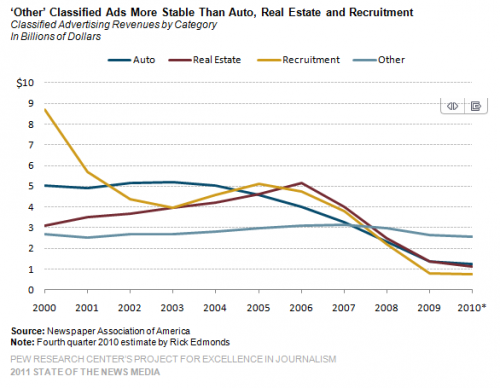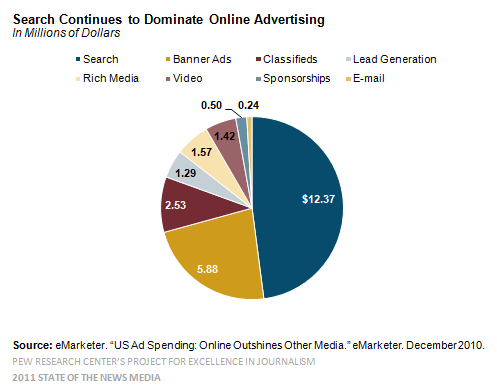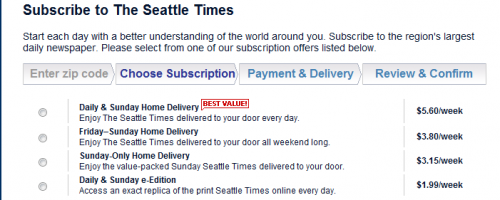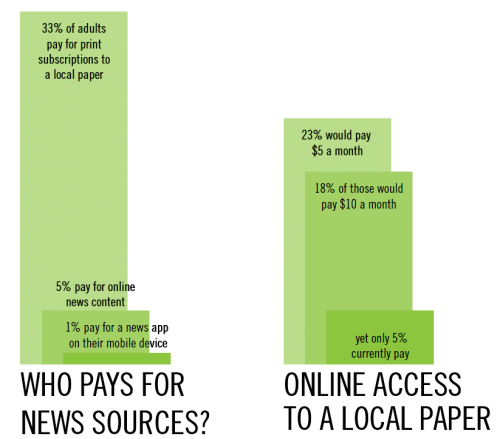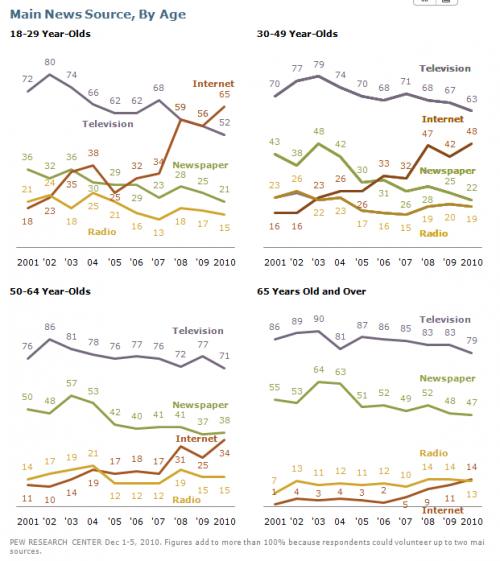The State of the News Media 2011: Americans Shifting to Online News, Still Only Paying for Print
Everyone knows that print newspaper circulation is declining and consumers are increasing accessing news online. Some may wonder why newspapers are slow to move way from print, but the truth is that print still provides the bulk of newspaper revenue and at this point, print heavily subsidizes online efforts. Print, then, enables newspapers to experiment […]
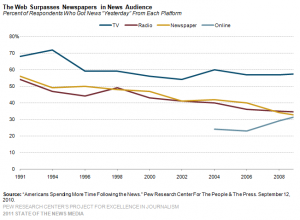
The question then, is this. If consumers are increasingly getting their news online rather than in print, how can newspapers replace print revenue with online revenue? A new study by Pew Research Center’s Internet & American Life Project and Project for Excellence in Journalism, in partnership with the John S. and James L. Knight Foundation, sought the answer to this question, as well as details about how Americans consume news.
Advertising Revenue
A big part of monetary puzzle is advertising dollars, as this accounts for most revenue. Between 2003 and 2010, online ad dollars are up, but not enough to account for declining print advertising.
This problem is more complex than simply how we access news information. Classified advertising, for instance, is down 70% since 2000, but that’s likely more due to our increased use of online vertical search than it is due to how we read local news.
Have Craigslist and eBay taken the place of newspaper classifieds? In part. Looking more closely at verticals though, our shift to searching online for cars, real estate, and (particularly) jobs has made the most impact.
In general for online advertising, search continues to be dominant (vs. the display advertising and online classifieds that online news tends to offer). A shift to advertising based on internal site search may be one promising area to explore.
Online display advertising has seen an increase over 2009, however.
Do Consumers Pay for Content?
The willingness of consumers to pay for content is an important element in the overall mix.
Why is it that we have traditionally been willing to pay for the printed newspaper (or magazine) but not the online equivalent? As consumers, we seem to be more easily making the transition with books. We don’t expect to get novels for free and in fact, many of us pay for electronic book readers in addition to the books themselves.
The study finds that while Americans still mostly only pay for print news, more of us now access our news online (46%) than in print (40%). (Local TV news still edges them both out at 50%). But circulation revenue is down only about 10% from 2003 (and since advertising is down significantly more, circulation dollars now make up 27% of revenue).
Mobile Apps?
If book readers such as the Kindle and iPad were the catalyst for online book revenue, will mobile apps do the same for news? That’s one of the questions that the study took on. They found that 47% of Americans access some local news on a mobile device such as a mobile phone or iPad. But while 36% of American adults say they pay for local news content, 31% do so via print newspaper subscriptions (5% pay for online news and 1% pay for mobile apps).
Would we pay for online access if print went away? Maybe. 23% say yes if the cost was $5 a month. How does that compare to print rates? I can get the Seattle Times delivered to my door daily for $22.40 a month or “an exact replica” online around $8 a month.
Why are we willing to pay more than four times the cost for the print version? The online version should be less expensive to produce, but from a value perspective (putting aside that the online version of the news shouldn’t be an “exact replica” of the print version), we get faster, more convenient, and more interactive content online. (These before and after photos of the Japanese earthquake wouldn’t be the same in print, for instance.)
Looking more closely, perhaps part of why only 5% of are paying for online news access is that we’re willing to pay up to $5, while the cost is $8. The Seattle Times could drop the online price to $5 see if that encouraged more sign up, but they understandably may be concerned about cannibalizing print revenue (which they need to keep the online version afloat). But they need to transition into an online revenue model at some point because print will continue to dry up in any case. It’s a conundrum.
Part of the issue in paying for news is that nearly 60% of those over 65 pay for news, but only 8% in that age group access news on mobile devices. Only 20% of those 18 to 29 pay for news, but 70% in that age bracket access news on mobile devices.
Everyone seems to get most of their news from TV (other than the youngest age bracket), but for those under 50, the internet is second vs. the newspaper for those over 50.
You can access all of the findings at the State of the News Media 2011 site. And you can access the full PDF of the infographic on how we access and pay for local news at Nine By Blue.
Related:
Opinions expressed in this article are those of the guest author and not necessarily Search Engine Land. Staff authors are listed here.
Related stories


